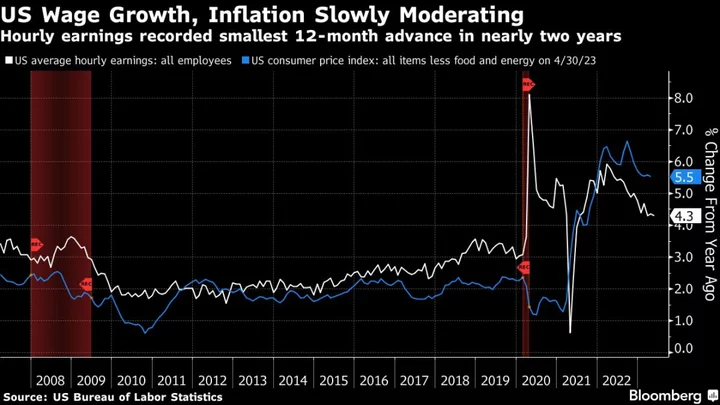Federal Reserve officials are rethinking their view that wage gains are fueling inflation, a key intellectual shift that bolsters the case for a pause in their tightening campaign this week.
Until recently, many top policymakers at the US central bank maintained that the road to lower inflation ran through the job market. The idea was that, because labor costs make up a substantial portion of the cost of providing services — an area where price pressures have been especially persistent — workers would need to feel some “pain” in the form of smaller wage increases for inflation to be brought under control.
But new research and commentary from officials and economists suggest the link between wages and prices may not be so direct. And it’s arriving just as the Fed is nearing the likely end of what has been a historic cycle of interest-rate increases over the past 15 months.
“If the link between wages and inflation isn’t as strong as policymakers believe, then you do run the risk of softening the labor market significantly without seeing much progress on inflation from that end,” said Preston Mui, a senior economist for Employ America, a think tank that supports pro-labor policies. “That sort of uncertainty all around is good enough reason for them to lean toward a skip at this next meeting.”
Fed officials last month authorized a 10th straight increase in the central bank’s benchmark interest rate, taking it above 5% for the first time since 2007, and signaled they may stop raising rates at this week’s policy meeting.
That signal came despite inflation’s slow progress in returning to their 2% target after reaching a four-decade high in 2022. The latest consumer price index figures are due Tuesday, and forecasters expect them to show core inflation, excluding food and energy, moderated to 5.2% in May from a year earlier.
The prospect of tighter credit conditions in the wake of several bank failures earlier this year helps explain policymakers’ willingness to take a break. So does the tentative change in attitudes toward wages.
Read More: Powell Faces Pushback Inside Fed Over Need to Cool Wage Gains
Minutes of the Fed’s May 2-3 policy meeting hinted at a shift. When discussing services inflation in particular, only “some participants remarked that a further easing in labor market conditions would be needed” to bring it down, whereas minutes of the previous meeting in March suggested “participants generally judged” such cooling would be necessary.
“I do not think that wages are the principal driver of inflation,” Fed Chair Jerome Powell told reporters after the May meeting. “I think wages and prices tend to move together, and it’s very hard to say what’s causing what.”
Powell’s remark alluded to a crucial question in the emerging wages-versus-prices debate: Are wages a large driver of inflation, or is it more likely to be the other way around? Public comments from officials in recent months suggest the latter interpretation is gaining a following.
Lower Profits
Meanwhile, new research from within the Fed system also supports that thesis.
A statistical analysis suggests faster wage growth has contributed only minimally to faster services inflation in recent years, San Francisco Fed economist Adam Shapiro said in an article published on the bank’s website last month. He noted businesses can “absorb” those costs via lower profits or by using automation and other methods to improve efficiency, adding that “recent evidence shows that wage growth tends to follow inflation, as well as expectations of future inflation.”
Before the pandemic, Paloma Clothing in Portland, Oregon, often offered employees a pay bump of as much as 3% at the start of every year. But inflation changed that equation.
The retail store now relies on stronger wage increases and robust benefits in order to retain its roughly 20 employees, said account manager Traci Burnes.
“Inflation has a lot to do with our raises,” Burnes said. But despite the higher wages, she says the company that’s been in business for nearly five decades has managed to avoid passing those costs on to consumers when it’s not necessary. “That’s definitely a case-by-case situation. We’re not raising prices across the board,” she said.
Many companies like Paloma Clothing continue facing pressure to boost pay. A still historically elevated 41% of small-business owners on net said they raised compensation in May, according to a National Federation of Independent Business survey. The percentage of firms planning to raise wages in the next three months, however, has in recent months moderated to pre-pandemic levels, around one in five on net.
Such businesses will first try to absorb higher costs by accepting lower profit margins, and then will try to pass the costs on to their customers in the form of higher prices as they “try and balance how much they can increase compensation and stay competitive,” said Holly Wade, executive director of the NFIB Research Center.
The government’s latest monthly jobs report, meanwhile, offered mixed signals on the strength of the labor market, with job creation topping forecasts even as average hourly earnings in the 12 months through May rose at the slowest pace in nearly two years.
Read More: Looking Beyond Mixed Signals, US Labor Market Remains Strong
Omair Sharif, the president and founder of Inflation Insights LLC, said wage pressures don’t map neatly to categories of the consumer price index that have played the biggest role in boosting services inflation. But even setting the wage question aside, he sees a sharp deceleration in price increases over the next few months as momentum in travel-related industries wanes.
“We don’t know for sure, but it feels like, and the data is suggesting, that things maybe have slowed down more than you’d like to see,” Sharif said. “The risk management approach to monetary policy, especially now that you have already raised rates so much, to me suggests that this is a time for patience, and to watch the data.”

